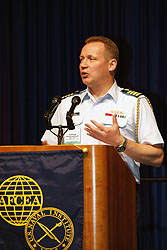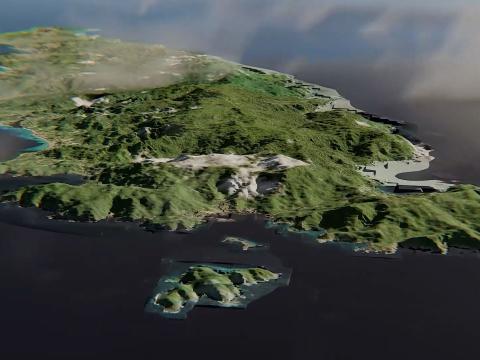West 2011 Online Show Daily: Defense Doctrines, Processes Face Fundamental Shifts
From the battlespace to the boardroom, the way of doing things in the past is passé.
Quote of the Day:
“Adaptability often is viewed as a responsive act. However, adaptability and preparation are inexorably linked.”—Alfred Grasso, president and chief executive officer, the MITRE Corporation
Revolutionary ideas are leaving the think tank and entering the policy realm as defense institutions grapple with reforms amid exceedingly rapid change. With information technology (IT) serving an increasingly vital role in warfighting, finding new ways of acquiring and managing it has become paramount. And, as adversaries adapt their tactics to avoid U.S. strengths and exploit potential weaknesses, the ability to adapt U.S. forces is essential to prevailing on the battlespace.
These were among the topics discussed on the third and final day of West 2011 in San Diego. Two discussion groups comprising policy shapers gave the audience a view of potentially new era—if their proposed changes come to pass.
A recent Defense Science Board study explored military adaptability, and its two chairmen gave their audience a glimpse of its results. Alfred Grasso, president and chief executive officer, the MITRE Corporation, and Dr. William A. LaPlante, head, Global Engagement Department, Johns Hopkins University Applied Physics Laboratory, described the four themes that dominated the study: aligning the enterprise with an operational cadence; creating global situational awareness through small teams developing contextual awareness; preparing for degraded operations; and human capital.
Discussing the operational cadence theme, Grasso pointed out that a planning-centric environment does not align well with the current situation—it must have a closer link with the operators. Functional development teams, such as those used for the development of the F-117 stealth fighter, are a good approach.
Grasso supported the idea of planned adaptability. “Adaptability often is viewed as a responsive act,” he said. “However, adaptability and preparation are inexorably linked.”
| |
| (l-r) Rear Adm. Daniel R. Bowler, USN (Ret.), leads a discussion with Alfred Grasso and Dr. William A. LaPlante. |
Looking at creating global situational awareness, Grasso stated that a key element is the exploitation of open source information. With more than 500 exabytes of information residing on the Internet, the Defense Department is woefully underinvested in this discipline, he said.
LaPlante charged that U.S. forces are not well prepared for degraded operations. He noted that one common characteristic is that militaries that trained with realistic degraded operations—brutal honesty and realism—did much better than those that didn’t. While the realism of degraded operations across the services is good at the command level, the operational level is another story. With two exceptions—cyber and space—the realism is not there at that level. He called for more realism in operational exercises, and he cited the advantages of red/blue teaming—where technicians and engineers find vulnerabilities and fix them simultaneously.To address the human capital issue, LaPlante focused on hiring authorities. The Defense Advanced Research Projects Agency (DARPA) has 20 hiring experts, while the entire Navy also has 20. He called for greater exploitation of hiring experts, especially for special disciplines such as intelligence.
One of the most urgent reform requirements involves IT, and two top Defense Department experts offered their take on the way ahead for reforming IT acquisition and management. Elizabeth A. McGrath, Defense Department deputy chief management officer, and David Wennergren, Defense Department assistant deputy chief management officer, told the Thursday luncheon audience that revolutionary changes could be coming to IT acquisition if participants sign on for conducting business in radically new ways.
McGrath and Wennergren described how their office is proposing a new approach to IT procurement that would emphasize transparency both to improve performance management and to build trust. The goal is to create a culture of outcome-based measures.
| |
| Elizabeth A. McGrath, Defense Department deputy chief management officer, discusses information technology acquisition reform with David Wennergren, assistant deputy chief management officer. |
Wennergren noted that all processes for IT production must change. Some of these changes may require new or revised laws. McGrath explained, “We are looking to break down the existing process for IT procurement to have more modular, faster delivery of these capabilities.” She added that currently, “we’re not hitting the capabilities in the first five years.”
These vast changes proposed by the office will require all participants to do their part, or the effort will fall short. “It’s a matter of choice,” McGrath declared. “If we decide we won’t, then we are detracting from the department’s goals.“I’m not painting a picture of doom and gloom,” she continued. “The opportunities are sitting right there in front of us.”
One IT problem facing many defense and homeland security organizations is data sharing, and the U.S. Coast Guard in particular faces many hurdles in that arena. Its missions are becoming more complex, and its requirements for sharing data are growing exponentially with the threat.
Rear Adm. (S) Stephen Metruck, USCG, chief of staff, Eleventh Coast Guard District, told the Thursday breakfast audience that the threats facing the Coast Guard may be combining to pose a greater danger to the United States. So, the need for data sharing across agencies and services is more vital than ever.
However, many firewalls prevent government agencies from linking their databases, even within the Department of Homeland Security. In some cases, the only solution is to place people from different agencies side-by-side so that they can share views on their computer displays, the admiral observed.
And these threats may be joining forces. Drug smuggling, alien immigration and terrorism are finding common ground and advantages to be gained by combining their tactics and technologies. Semisubmersible craft used to smuggle drugs from South and Central America to the United States are becoming more sophisticated to the point of being minisubmarines. These craft also could be used to smuggle terrorists and weapons of mass destruction past border patrols.
|
| Rear Adm. (S) Stephen Metruck, USCG, chief of staff, Eleventh Coast Guard District, describes the new challenges facing his service. |
Security at the border is not sufficient to protect the United States from these threats. “Goal defense” is not an effective way of stopping adversaries, the admiral explained, so the Coast Guard is striving to head off threats before they near the homeland.
Adm. Metruck described how the Coast Guard is working to develop new methods of detecting and identifying threats before the marauders launch their plans into action. Operation Focused Lens, for example, looks at places from where attacks may come. The goal is to detect anomalous activity before a smuggling or terrorist boat is launched. Marina operators would be engaged through an outreach program to report suspicious signs such as boaters practicing illegal activities.The Coast Guard also is seeking increased maritime domain awareness at the tactical level, with a focused and coordinated presence in areas where small boat attacks may be staged, originated or executed. For ocean operations, it is looking at deploying the FireScout unmanned aerial vehicle (UAV) on its national security cutter. It also may employ a maritime Predator UAV. Adm. Metruck stated that shifting from manned to unmanned systems offers a great deal of potential for Coast Guard maritime domain awareness.
Mark your calendar for West 2012, January 24-26 at the San Diego Convention Center.





Comments